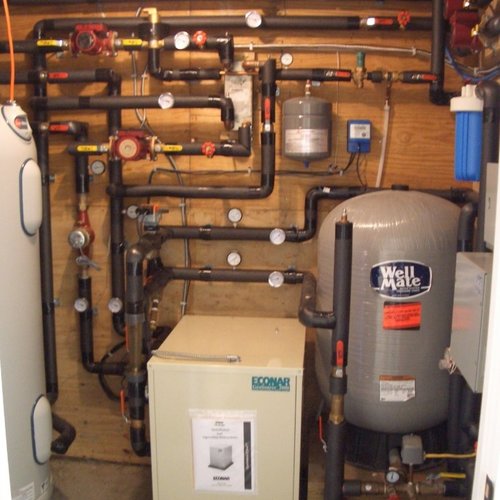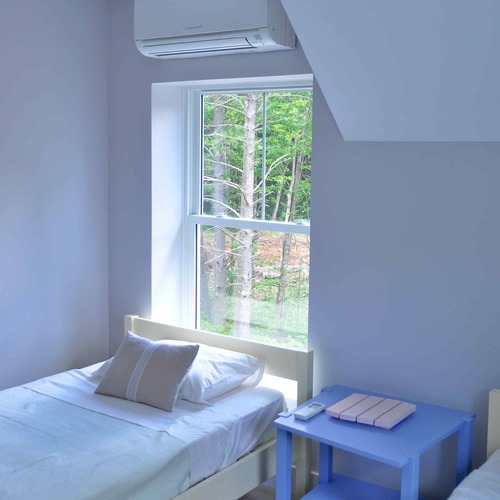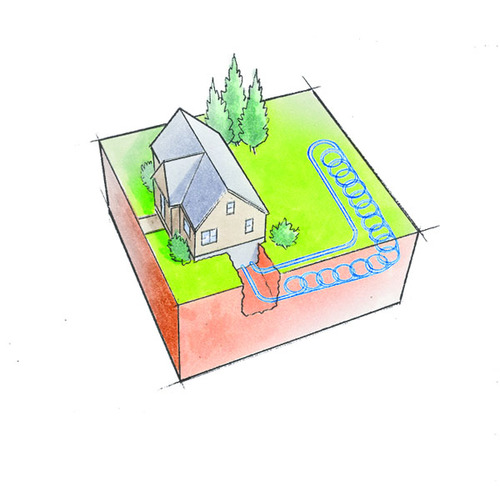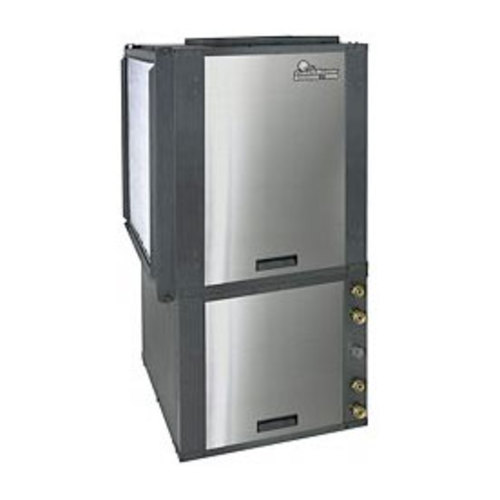
Most residential heat pumps in the U.S., including ductless minisplits and ducted minisplits, are air-source heat pumps. During the summer, this type of heat pump acts like an air conditioner: it collects heat from indoor air and transfers the heat to the outdoor air. During the winter, the heat pump reverses direction: it collects heat from the outdoor air and transfers the heat to the indoor air.
A second type of heat pump is the ground-source heat pump (GSHP). During the summer, this type of heat pump transfers heat from indoor air to the soil around your house. In some cases, it may transfer heat from indoor air to the water in a drilled will, or to a nearby lake or pond. During the winter, a GSHP collects heat from the soil around your house (or from the water in a drilled well or nearby pond) and transfers the heat to indoor air.
To effect this heat transfer, a ground-source heat pump system requires either buried tubing—vertical loops of tubing inserted into boreholes, or horizontal lengths of tubing buried in deep trenches—or the circulation of water from a drilled well or pond through tubing that conveys the water to the heat pump.
Some manufacturers of ground-source heat pumps state that their equipment gathers renewable energy, or label their equipment as “geothermal.” To clear up these misconceptions: a ground-source heat pump does not use geothermal energy. It isn’t a type of renewable energy system. Like an air-source heat pump, it’s simply a type of heating and cooling system that uses electricity as its fuel.
Air-source heat pumps are much cheaper and almost as efficient
GBA has dozens of articles on ground-source heat pumps (many of which are listed in the “Related Articles” sidebar). If you are…
Weekly Newsletter
Get building science and energy efficiency advice, plus special offers, in your inbox.

This article is only available to GBA Prime Members
Sign up for a free trial and get instant access to this article as well as GBA’s complete library of premium articles and construction details.
Start Free TrialAlready a member? Log in















14 Comments
This is all fair criticism. As an engineer, I was delighted to participate in the engineering project of designing a system for my house and tweaking it to get excellent performance, all for a cost at the low end of your range (15 years ago). But the experience also underscored how difficult it would be for someone without engineering expertise to achieve a similar result.
However, there is an advantage that I don't see mentioned here that I think will be increasingly important in the coming decades. That is, even if the total annual electric consumption of a good air-source heat pump installation is not significantly different from that of a good ground-source heat pump installation, the peak electricity consumption on a cold January night is significantly more for an air source heat pump. For the consumer, that doesn't matter, because it's the total energy consumption that you pay for not the peak load. But for grid operators, that difference really matters. With an increasing percentage of variable renewable sources on a grid, including solar (which doesn't produce anything through a long January night), and with increasing electrification of heating, the fact that air-source heat pumps’ COP drops right when you need them most is a concern, and is a motivation to continue trying to improve approaches to cost-effectively installing and commissioning these systems.
Companies like Dandelion are working on making the installation more systematic, to lower cost and avoid problems, and to do drilling with right-sized equipment and approaches that minimize overhead.
It’s not a good choice right now for a typical homeowner, but I’m not ready to give up on it as a technology that should be used in the future.
"Some manufacturers of ground-source heat pumps state that their equipment gathers renewable energy, or label their equipment as “geothermal.” To clear up these misconceptions: a ground-source heat pump does not use geothermal energy. It isn’t a type of renewable energy system. Like an air-source heat pump, it’s simply a type of heating and cooling system that uses electricity as its fuel."
A basic but important distinction that somehow up to now had eluded me.
Alternatively, we could say that air-source heat pump utilize renewable tropospherothermal energy.
Charlie,
Maybe you could. I've tried three times to say that word and can't.
Have you seen the pilot geogrid projects? The basic idea is a network of boreholes at the street sharing water in a network between houses, businesses, etc. They're testing to see if it makes economic sense and if current gas providers could essentially switch to thermal.
https://heet.org/2022/02/28/six-geogrid-demos-approved-for-massachusetts/
There are multiple locations for the pilots, both MA gas utilities are participating.
It does seem one of the details of the Inflation Reduction Act includes renewal and updating of section 25C. It changes the rebate on all heat pumps (among other things) to 30% with a cap of $2,000/year. The current geothermal tax rebate is extended until 2033 at 30% as well. This bill has not yet passed at this time, but worth noting.
EDIT: After a little closer look - the rebate is 50% of the heat pump cost ($8k max) if your household income is less than 150% of the median. Which for my metro Detroit area, ends up being $136k! The 30%/$2000 max is if your income is above the 150% threshold. Rebate is 100% if your income is less than 80% of the area median. I think we will see a LOT more air source heat pumps in the coming years. It will be interesting to see how the technology evolves.
I recently become aware of an "open-loop" geo system that uses your existing well water as the source for the heat exchanger. I am just beginning my research and would like to know if anyone has experience or comments to share.
Are you referring to "pump and dump"? This uses fresh groundwater one time to extract the heat or the cold and then runs it on the ground surface to end up in the nearest watershed.
Yes, that is correct. The water is expelled to the watershed after use. I can't quote specs, but was told that it uses very little water and is very efficient.
Can anyone shed some light on cost difference between a ground sourced heat pump and air sourced heat pump excluding the ground loop costs?
I’m designing a rural residence (better than PGH) in 7A (1hr north of MN border). Space is not an issue and I have my own excavation equipment.
Could a ground sourced heat pump make more sense in my situation?
I'd also love the same insight!!! It is challenging to snuff out if the life cycle cost benefit of the GSHP is squashed solely by the labour cost of putting the loops in.
JMRtibay and User 1010245,
Obviously if "space is not an issue" and you "have your own excavation equipment," it will be far cheaper for you to install a ground-source heat pump system than most homeowners. If you are a skilled equipment operator, and you know what you are doing, and if the engineering and design specifications for your project are done well, you can end up with a great system at a reasonable price.
That said, there are still a lot of ways you can screw things up -- for example, by digging trenches that aren't deep enough, aren't wide enough, aren't long enough, or specifying ground loop piping of an inappropriate diameter or the wrong pump.
One thing that I did not see discussed as an advantage that ground source has appears to have a much larger "Delta T" cooling differential between intake and discharge temps. Air source appears to provide 18 to 26 degrees of cooling in reference to the outside temperatures, while ground source can provide a wider range due to the loop temperature being constantly within a small lower temperature range. Perhaps way off base here, please educate me if I am wrong. In Oklahoma, the days of temps continuously over 95 degrees seems to be increasing.
Loopback,
If the system is well designed, then the fluid temperature entering a ground-source heat pump will, indeed, be warmer in winter and cooler in summer than the outdoor air temperature. The result will be a slightly higher efficiency compared to an air-source heat pump.
The problem with a ground-source heat pump isn't efficiency or (usually) ground temperatures; the major problems are design issues (because each system requires custom engineering, and this work is often sloppy), installation issues (ditto), and the high cost of the hardware and loop installation (costs which energy savings are insufficient to justify).
Log in or become a member to post a comment.
Sign up Log in